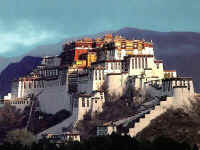|
TIBET Monday, 17 April. The breakfast buffet, like most of the meals at the hotel, was very poor. At 9:30 we drove the short distance to the Potala Palace. The Palace is an imposing site, standing high on Red Hill in the center of Lhasa (which otherwise is as flat as a pancake). Its origins can be traced to about 641 A.D. when the king who first unified Tibet built a palace on this hill. Most of it was destroyed over the ensuing centuries. The present palace was constructed (1645-1694), but incorporated some remains of the original palace. The Palace has two main sections. The Red Palace is nestled on top of the White Palace. The Red Palace (the religious part) contains the living quarters and tombs of most of the Dalai Lamas, as well as many temples housing thousands of gilded statues. The White Palace (the secular part), when Tibet was independent, housed the administrative offices of the Tibetan government. The Red Palace also contains two small chapels from the original 7th century Palace. As we were soon to discover, the Potala Palace draws thousands of Tibetan pilgrims every day. Our bus took us up a narrow drive on the left side of the Palace. We then walked further up and entered through a rear door on one of the highest floors. This meant that almost all our climbing would be down, an important advantage since the roof of the 13-story Palace is nearly 1,000 feet above the street in front of it. It also meant that we would be going in the opposite direction from the pilgrims who entered through the front door. Almost every pilgrim carried a "butter lamp" (or a cheaper substitute). Originally, this lamp was a small, brass, chalice-like cup filled with yak butter and having a wick in the center. Each shrine has hundreds of wicks burning in butter (like votive candles). The pilgrim would tilt his lit butter lamp so that a drop of his butter fell onto every wick in the shrine, in effect making every candle his own votive candle. Nowadays, the butter has largely been replaced by margarine, and many pilgrims do not purchase the brass lamps. We saw many who just carried an open kilo (2.2 lbs.) package of margarine and a spoon to hold over the flame. As you can imagine, the smell of all that margarine burning in crowded, confined spaces was sometimes overpowering. We climbed up to the roof of the Red Palace where there was a great view. The "stairs" were like uneven ladders, very difficult to negotiate. We worked our way down and forward through dozens of chapels and shrines, including the two from the 7th century. Tashi insisted on lecturing us on Buddhist theology and identifying each of the hundreds of statues by name. He had studied in India, and we suspect it was in a Buddhist monastery. His knowledge was impressive, but his lectures became very repetitive since statues of the same Buddhas recurred again and again. We finally came out the front entrance into a beautiful warm and sunny day. There were scores of vendors in little booths, but only a fraction of what we'd seen at the Great Wall. Our bus took us to the large square across the street where there was an unobstructed view of the front of the Palace. By 1:00 we were back at the hotel for lunch. At 2:30 we set out for the Sera Monastery (founded 1419). It was nestled at the foot of Tatipu Mountain outside of Lhasa at the end of an unbelievably bumpy dirt road. In Tibet the monasteries have long been the only available means of education for most young men. Before the Chinese takeover, there were about seven thousand monks in the three colleges that make up Sera. In March 1959, Chinese tanks bombarded the monastery. Many monks were killed. Many others fled to India where, eventually, a new Sera Monastery was established. Tashi, though a Tibetan, never mentioned anything about the Chinese invasion or the partial destruction of the Monastery. In fact, he got visibly nervous when any of us asked a question relating to Chinese-Tibetan relations. He did give us many more lectures on Buddhist theology. (They sounded like the same ones he'd given at the Palace). He showed us many elaborate shrines, collections of scriptures, and works of art. There were pilgrims everywhere because the Sera is one of Tibet's holy places. An interesting change, though, was our visit to the monastery's large courtyard crowded with monks engaged in animated debates. We got back to the hotel at 4:30. Jane was having nausea, either from the 12,000-foot altitude or from the altitude sickness medicine (diamox). We ate in the hotel at 6:30. The food was really bad. Often the only meat was at least 95% bone or gristle. We wondered what they did with the rest.
Copyright © 2000-2023 DarrellPeck.com All rights
reserved. |















